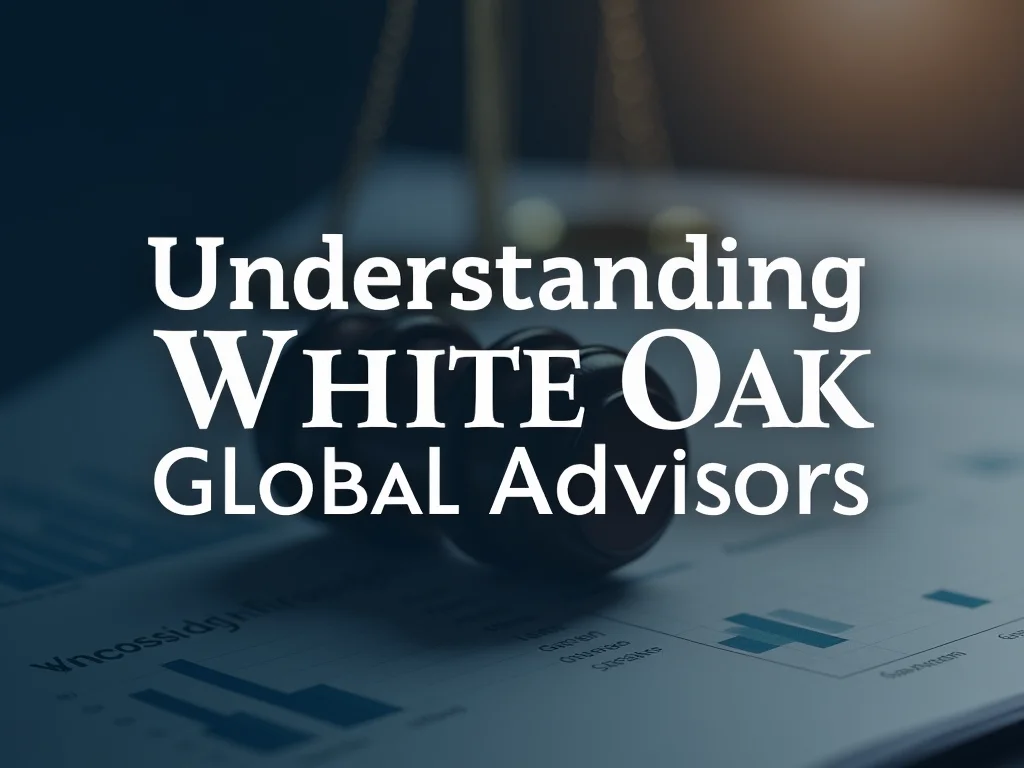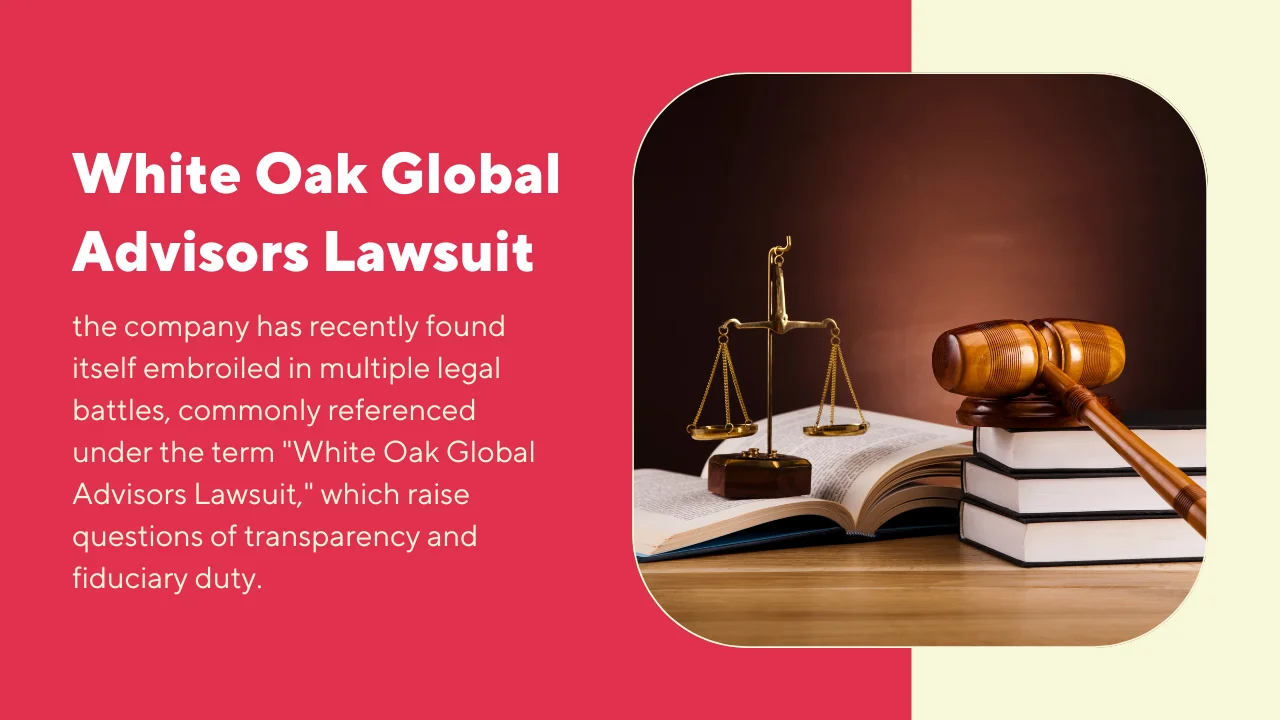The San Francisco-based investment powerhouse White Oak Global Advisors has extensive experience navigating the murky waters of the financial markets as a private equity and alternative credit specialist. However, the company has recently found itself embroiled in multiple legal battles, commonly referenced under the term “White Oak Global Advisors Lawsuit,” which raise questions of transparency and fiduciary duty. The most noteworthy of these disputes arose in 2017 when the New York State Nurses Association Pension Plan (NYSNAPP) sued White Oak, asserting that the company had violated its ERISA-mandated fiduciary duty. A federal judge decided to award over $96 million to NYSNAPP in 2022 as a result of this lawsuit, prompting further scrutiny into White Oak’s practices. As well as discussing the firm’s and the financial industry’s reactions to White Oak’s legal disputes, this article delves into the specifics of those disputes.
Understanding White Oak Global Advisors

Investment firm White Oak Global Advisors is well-known for providing innovative private equity and alternative credit solutions. White Oak offers credit solutions to many different industries, including healthcare and technology, and was founded with the goal of delivering high returns through targeted investment strategies. White Oak has successfully enticed institutional investors, such as endowments and pension funds, that are looking for diversification and stability through its positioning as an innovator in alternative financing.
Key Legal Conflicts and Their Implications

Core Allegations and Outcomes
In 2017, the key legal dispute surrounding White Oak arose when NYSNAPP began arbitration proceedings against the company. Allegations of ERISA violations related to White Oak’s hiring practices were the central point of this disagreement. Concerns regarding potential conflicts of interest and a lack of transparency arose when NYSNAPP claimed that White Oak had recruited Russell Niemie, who was then the company’s chief investment officer, without providing all relevant information.
Breach of Fiduciary Duty under ERISA
To guarantee that those in charge of retirement plans are looking out for the participants’ best interests, ERISA establishes strict standards for fiduciaries. The apparent conflict of interest arose in NYSNAPP’s case due to the undisclosed recruitment of Niemie, who had decision-making authority over the distribution of pension fund assets, including those managed by White Oak. White Oak was in breach of its fiduciary duty under ERISA, according to NYSNAPP.
The Arbitration Process and Federal Court Decision
A federal judge validated an award of $96 million in favor of NYSNAPP in March 2022, marking a turning point in the dispute that had progressed through lengthy arbitration proceedings. The importance of maintaining fiduciary standards in the investment industry, particularly when dealing with public funds such as pension plans, was highlighted by this decision of the courts. Investment firms were sent a strong message by the arbitration decision about the significance of being transparent and fulfilling their fiduciary duties.
Impact on White Oak’s Reputation
White Oak suffered heavy reputational and financial losses as a result of the arbitration award’s confirmation. This decision cast doubt on the firm’s dedication to its fiduciary duties, which is problematic for an organization that depends on institutional investors. Fiduciary breaches can cause trust to erode and investor relationships to suffer, as this case demonstrated.
Lessons for Fiduciary Responsibility in Investment Management
For the whole financial sector, the White Oak case is a lesson in caution. Given the importance of fiduciary duty in investment management, particularly for companies dealing with public funds, this case highlights the necessity for strong internal controls and open practices. To prevent similar conflicts and possible legal consequences, investment firms should establish rigorous compliance protocols.
| Aspect | Summary |
|---|---|
| Allegations (2017) | White Oak faced ERISA violation allegations for non-transparent hiring practices concerning Russell Niemie. |
| Fiduciary Breach | Accused of breaching fiduciary duty due to conflicts of interest and lack of transparency. |
| Legal Outcome (2022) | Federal judge awarded $96 million to NYSNAPP, emphasizing the importance of fiduciary standards in investment management. |
| Reputation Impact | Significant reputational damage highlighted the critical nature of adhering to fiduciary responsibilities. |
| Lessons for Industry | Stressed the importance of robust internal controls and transparent practices in managing public funds. |
Secondary Legal Disputes Involving White Oak
White Oak has been involved in multiple legal battles; one of these was in 2024 when it sued Thomas M. Clarke, Ana M. Clarke, and David Wiley in the U.S. District Court for the Southern District of New York. As this case progresses, it begs the question of White Oak’s approach to the law and its continued attempts to allay fears of lack of transparency.
The Thomas and Ana Clarke Case
The accusations against Thomas, Ana, and David Wiley center on their dealings with White Oak and their alleged breach of contract and misrepresentation. The details of this lawsuit are still coming to light, but it highlights the firm’s continuous struggle to effectively handle legal disputes.
Ongoing Litigation and Financial Implications
The financial ramifications are enormous as White Oak deals with numerous lawsuits. Massive legal battles like these can result in substantial settlements or damages, which in turn can cost a pretty penny. These cases highlight the need for alternative credit providers like White Oak to have proactive legal risk management strategies.
White Oak’s Legal Challenges

Investors have taken note of the growing number of lawsuits involving White Oak. Since clients may consider a firm’s legal stability when choosing an asset manager, analysts are worried that these lawsuits could hurt the firm’s future investment opportunities. Therefore, in order to overcome these obstacles, White Oak must be able to assure clients of its dedication to fiduciary standards.
The Role of Transparency and Ethics in Investment Management
The lawsuits filed against White Oak Global Advisors highlight the importance of being open and ethical when dealing with investors. Adherence to fiduciary duty is of the utmost importance for investment firms, especially those dealing with retirement funds. These cases have served as a reminder to the financial industry of the significance of maintaining public trust by adhering to strict ethical standards and regulations.
Understanding Fiduciary Responsibilities and Legal Boundaries
Fiduciary responsibilities are an essential component of any legal framework for firms like White Oak that handle client assets. In the financial sector, a fiduciary duty entails being totally forthright and responsible while looking out for the client’s best interests. When dealing with delicate assets, such as pension funds, which affect people’s post-retirement financial stability, this responsibility becomes even more paramount. The difficulties encountered by White Oak serve to emphasize the complexity and high standards that are associated with fiduciary responsibilities in the investment industry.
Defining Fiduciary Duty in Investment Management
Investment managers have a fiduciary obligation to put their clients’ interests first, which includes being forthright about all financial dealings and staying away from conflicts of interest. The court found White Oak to have violated their fiduciary duty because they hired NYSNAPP’s chief investment officer while managing the pension’s assets, which led to serious questions about openness and possible conflicts of interest.
Consequences of Fiduciary Breach
As demonstrated in the White Oak case, a violation of fiduciary duty can result in serious legal consequences, such as heavy financial fines. As the $96 million payout to NYSNAPP shows, there are major repercussions for those who breach their fiduciary duties. Damage to investor confidence can have far-reaching effects on customer retention and the firm’s reputation, in addition to the obvious monetary ramifications.
Preventing Fiduciary Breaches Through Internal Controls
Strict internal controls, such as thorough compliance protocols, frequent audits, and open communication with clients, are necessary for firms like White Oak to reduce the likelihood of fiduciary breaches. To protect client assets and the firm’s reputation, these practices help enforce accountability and guarantee that fiduciary duties are fulfilled.
The Impact of Regulatory Oversight on Investment Firms
The investing environment has changed in the past few years due to stricter regulations. The legal challenges faced by White Oak highlight the significance of following regulations meant to safeguard investors, especially in alternative credit and private equity, fields characterized by widespread problems with transparency. Particularly for firms dealing with pension and retirement funds, regulatory agencies such as the SEC have intensified their scrutiny of client disclosures, conflicts of interest, and fiduciary duties.
How ERISA Shapes Fiduciary Standards
Protecting participants and their beneficiaries is the primary goal of the Employee Retirement Income Security Act (ERISA), which sets out particular requirements for fiduciaries handling retirement assets. Heavy penalties are imposed for ERISA violations, like the ones that are alleged against White Oak. This highlights the Act’s role in holding entities accountable and protecting the interests of retirement fund participants.
Compliance Requirements for Alternative Credit Firms
The intricate character of alternative credit firms’ investment strategies makes them subject to distinct regulatory requirements, such as those faced by White Oak. In order to meet these requirements, firms need to keep detailed records of their client interactions, policies for handling conflicts, and fiduciary practices. Firms can remain operational in a highly regulated financial environment and withstand regulatory scrutiny if they comply.
Strengthening Investor Confidence Through Compliance
Building investor confidence requires strict adherence to regulatory standards. In order to repair its image and reassure its customers of its dedication to ethical investment practices, White Oak must show compliance and openness. By proactively addressing concerns regarding conflicts of interest and fiduciary duties, a transparent approach can also assist firms in mitigating potential legal challenges.
White Oak Case for the Investment Sector

The White Oak case is not only a warning to the investment management industry as a whole, but it also has far-reaching consequences for the firm. To maintain client confidence and comply with regulations, the legal battles have shown how important it is for the industry as a whole to adhere to ethical standards, be transparent, and have strong compliance protocols.
Setting Precedents for Fiduciary Standards
Case law involving White Oak has the potential to shape future fiduciary standards in the investment industry and establish significant precedents, especially for firms that handle public funds or retirement assets. No matter the investment strategy or type, these cases show that managers must put their clients’ interests first and act with fiduciary integrity.
Raising Awareness of Conflict of Interest Issues
The case highlights the need for open and honest conflict of interest management. In order to keep trust and adhere to fiduciary standards, it is important to disclose potential conflicts of interest, as shown when White Oak recruited NYSNAPP’s CIO during their management contract. Investment firms must be aware of this in order to avoid similar legal challenges.
Encouraging Stronger Compliance Programs in Investment Firms
The necessity of strong compliance programs is one of the most important takeaways from White Oak’s story. For investment firms to avoid violating their fiduciary duty, they need to put in place thorough compliance procedures. Organizations can encourage moral behavior that values openness and honesty and reduces the likelihood of legal conflicts by enhancing compliance procedures.
FAQs
1. What is the White Oak Global Advisors lawsuit about?
The lawsuit centers on alleged breaches of fiduciary duty, particularly surrounding ERISA violations due to undisclosed recruitment and conflicts of interest.
2. Who are Thomas and Ana Clarke in relation to White Oak’s lawsuit?
Thomas and Ana Clarke are among the defendants in a 2024 lawsuit filed by White Oak involving allegations of breach of contract and misrepresentation.
3. How much was White Oak ordered to pay NYSNAPP?
White Oak was ordered to return over $96 million to NYSNAPP as part of a federal court arbitration award.
4. Why is fiduciary duty important for investment firms?
Fiduciary duty ensures that investment firms act in their clients’ best interests, maintaining transparency, ethical standards, and avoiding conflicts of interest.
5. What are ERISA violations?
ERISA violations occur when fiduciaries managing retirement assets fail to meet established standards, such as acting in the best interest of beneficiaries.
Also Read: Smoothstack Lawsuit
Conclusion
White Oak Global Advisors’ legal troubles highlight the importance of investment management industry standards of candor, openness, and compliance. The White Oak Global Advisors Lawsuit shows how crucial it is to manage clients’ interests ethically, particularly with regard to delicate assets like pension funds. Building investor trust and maintaining a strong reputation in a competitive market can be achieved by investment firms that prioritize transparency, address conflicts of interest, and adhere to regulatory requirements. The incident at White Oak highlights the far-reaching effects of fiduciary breaches and the significance of proactive compliance in building trust with clients and staying in line with regulations.

Diane Wood is a talented blogger at Vistazens.com, covering a wide range of subjects, including technology and culture. Her work highlights the connections between modern life and long-standing traditions, while simplifying the latest innovations and sustainability efforts for readers.

